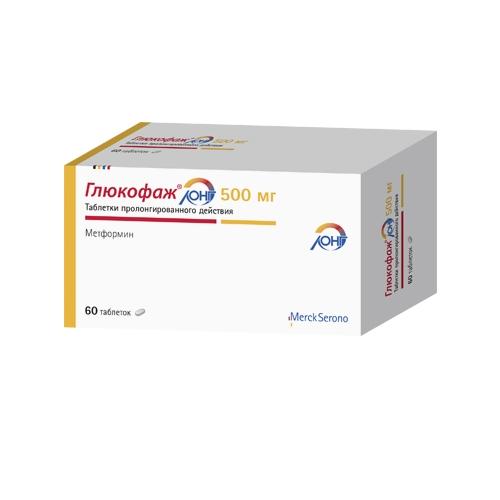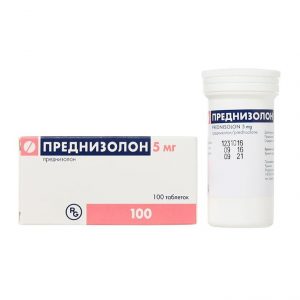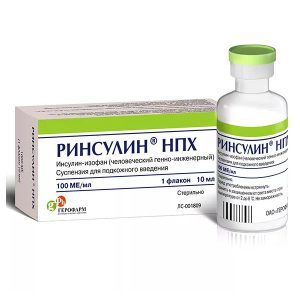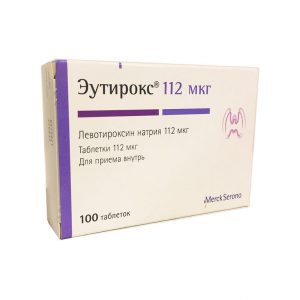Description
Release form
Long-acting tablets.
Packing
60 pcs.
Pharmacological action
Oral hypoglycemic preparation from the biguanide group, which reduces both basal and postprandial plasma glucose levels. It does not stimulate insulin secretion and therefore does not cause hypoglycemia. Increases the sensitivity of peripheral receptors to insulin and the utilization of glucose by cells. Reduces liver glucose production by inhibiting gluconeogenesis and glycogenolysis. Delays intestinal absorption of glucose.
Metformin stimulates glycogen synthesis by acting on glycogen synthetase. Increases transport capacity of all types of membrane glucose transporters.
Contraindications
Diabetic ketoacidosis, diabetic precoma, coma.
Renal failure or impaired renal function (CC less than 60 ml / min).
Acute conditions with a risk of developing renal dysfunction, including dehydration (with diarrhea, vomiting), severe infectious diseases, shock.
Clinically expressed manifestations of acute and chronic diseases that can lead to the development of tissue hypoxia (including heart or respiratory failure, acute myocardial infarction).
Extensive surgery and injury when insulin therapy is indicated.
liver failure, impaired liver function.
Chronic alcoholism, acute alcohol poisoning.
Lactic acidosis (including history).
Use for at least 48 hours before and within 48 hours after conducting radioisotope or x-ray studies with the introduction of iodine-containing contrast medium.
Compliance with a low-calorie diet (less than 1000 kcal / day).
Pregnancy.
Lactation (breastfeeding).
Age to 18 years.
Hypersensitivity to the drug.
Caution: the drug should be used in patients older than 60 years who perform heavy physical work, which is associated with an increased risk of developing lactic acidosis in them.
Use during pregnancy and lactation
When planning pregnancy, as well as in the event of pregnancy while taking the drug Glucofage Long, the drug should be discontinued to prescribe insulin therapy. The patient should inform the doctor about the onset of pregnancy while taking Glucofage Long.
Metformin is excreted in breast milk. Side effects in newborns during breastfeeding while taking metformin were not observed. However, due to the limited amount of data, the use of the drug during breastfeeding is not recommended.
Special instructions
Lactic acidosis is an extremely rare but serious (high mortality rate in the absence of emergency treatment) complication that may occur due to cumulation of metformin. Cases of lactic acidosis in patients receiving metformin occurred mainly in patients with diabetes mellitus with severe renal failure.
Other related risk factors should be considered, such as poorly controlled diabetes, ketosis, prolonged fasting, excessive alcohol consumption, liver failure and any condition associated with severe hypoxia. This can help reduce the incidence of lactic acidosis.
The risk of lactic acidosis should be considered when nonspecific signs such as muscle pain, cramps accompanied by dyspepsia, abdominal pain, general weakness, and severe malaise appear. In this case, the patient should stop taking the drug and consult a doctor immediately.
Lactic acidosis is characterized by acidotic shortness of breath, abdominal pain and hypothermia followed by coma. Diagnostic laboratory parameters are a decrease in blood pH (less than 7.25), a lactate content in blood plasma of more than 5 mmol / l, an increased anion gap and a lactate / pyruvate ratio. If metabolic acidosis is suspected, the patient should stop taking the drug and consult a doctor immediately.
Metformin should be discontinued 48 hours before elective surgery and can be continued no earlier than 48 hours after, provided that renal function was found to be normal during the examination.
Since metformin is excreted by the kidneys, before starting treatment, and regularly thereafter, it is necessary to determine the content of serum creatinine and / or KK: at least 1 time per year in patients with normal renal function, and 2-4 times per year in elderly patients, as well as in patients with CC at the lower limit of normal. Glucofage Long therapy is recommended to begin after an assessment of renal function. With a decrease in QC, renal function should be monitored at least 2-4 times a year.
Special care should be taken in case of possible impaired renal function in elderly patients, while the use of antihypertensive drugs, diuretics or NSAIDs.
The patient should inform the doctor about the appearance of a bronchopulmonary infection or an infectious disease of the genitourinary organs.
Routine laboratory tests should be performed regularly to monitor diabetes.
During treatment, patients should refrain from drinking alcohol.
It is necessary to warn the patient that the inactive components of Glucofage Long can be excreted unchanged through the intestines, which does not affect the therapeutic activity of Glucofage Long.
Influence on the ability to drive vehicles and control mechanisms
Monotherapy with Glucophage Long does not cause hypoglycemia, and therefore does not affect the ability to drive and operate machinery.
However, patients should be cautioned about the risk of hypoglycemia when using metformin in combination with other hypoglycemic drugs (sulfonylureas, insulin, repaglinide).
Composition of
1 tablet contains:
active substance: metformin hydrochloride – 0.500 g
excipients: povidone medium molecular weight (polyvinylpyrrolidone medium molecular weight) – 0.017 g croscarmellose sodium (primrose srflpf8f8f8 gf8f8f8f8f8f8f8f8f8f8f8f8f8f8f8f8f8f8f8f8f8f8f8f8f8f8f8f8f8f8f8f8f8f8f8f8f8f8f8f8f8f8f8f8f8f8f8f8f8f8f88 tablet contains:
active substance: metformin hydrochloride – 1 g
excipients: medium molecular weight povidone (medical polyvinylpyrrolidone medical) – 0.034 g croscarmellose sodium (primellose) – 0.016 g magnesium stearate – 0.010 g .
Excipients: sodium carmellose, hypromellose 2910, hypromellose 2208, microcrystalline cellulose, magnesium stearate.
Dosage and administration of
The drug is taken orally. The tablets are swallowed whole without chewing, washed down with a small amount of water.
The drug is taken during dinner (1 time / day) or during breakfast and dinner (2 times / day). Tablets should be taken only with meals.
The dose of the drug is determined based on the glucose content in blood plasma.
Monotherapy and combination therapy in combination with other hypoglycemic agents
Glucofage Long is prescribed in an initial dose of 500 mg (1 tab.) 1 time / day during dinner.
When switching from Glucofage (tablets with the usual release of the active substance), the initial dose of Glucofage Long should be equal to the daily dose of Glucofage.
Dose titration: depending on the glucose content in the blood plasma, every 10-15 days the dose is slowly increased by 500 mg to the maximum daily dose.
The maximum daily dose of Glucofage Long is 2 g (4 tablets) 1 time / day during dinner.
If glucose control is not achieved at the maximum daily dose taken 1 time / day, then you can consider dividing this dose into several doses per day according to the following scheme: 2 tab. during breakfast and 2 tab. during dinner.
When using the drug Glucofage Long with insulin, the usual initial dose of the drug is 500 mg (1 tab. ) 1 time / day, and the dose of insulin is selected based on the results of measuring glucose in the blood plasma.
Glucophage Long should be taken daily, without interruption. If treatment is discontinued, the patient should inform the doctor.
If you skip the next dose, the next dose should be taken at the usual time. Do not double the dose of the drug.
Special patient groups
In elderly patients and patients with reduced renal function: the dose is adjusted based on an assessment of renal function, which must be performed regularly at least 2 times a year.
Glucofage Long should not be used in children and adolescents under 18 years of age due to lack of data on the use.
Side effects of
Determination of the frequency of side effects:
Very often (? 1/10).
Often (? 1/100, <1/10). Infrequently (? 1/1000, <1/100). Rarely (? 1/10 000, <1/1000). Very rarely (<1/10 000), single - cannot be evaluated with the available data. Side effects are presented in decreasing order of importance. From the side of the nervous system: often – taste disturbance (metallic taste in the mouth). From the digestive system: very often – nausea, vomiting, diarrhea, abdominal pain, lack of appetite. Most often they occur in the initial period of treatment and in most cases pass spontaneously. To prevent symptoms, it is recommended that you take metformin with meals. Slow dose increases can improve gastrointestinal tolerance. From the skin: very rarely – erythema, itching, urticaria. From the side of metabolism: very rarely – lactic acidosis. With prolonged use of metformin, a decrease in the absorption of vitamin B12 is possible, accompanied by a decrease in its concentration in the blood serum. If megaloblastic anemia is detected, the possibility of such an etiology must be considered. From the hepatobiliary system: there are few reports of impaired liver function or hepatitis after the withdrawal of metformin, adverse events completely disappear. If dyspeptic symptoms do not disappear, treatment with metformin should be discontinued. Drug Interactions Contraindicated combinations Against the background of functional renal failure in patients with diabetes mellitus, a radiological study using iodine-containing radiopaque agents may cause the development of lactic acidosis. Glucophage Long should be discontinued 48 hours before and not renewed earlier than 2 days after an X-ray examination using iodine-containing radiopaque agents, provided that renal function was recognized as normal during the examination. Not recommended combinations Ethanol increases the risk of developing lactic acidosis during acute alcohol intoxication, especially in case of malnutrition, low-calorie diet, and liver failure. During treatment, do not use drugs, containing ethanol. Combinations requiring caution Medicines with indirect hyperglycemic effect (e.g., glucocorticosteroids and tetracosactides for systemic and topical use, beta2-adrenergic agonists, danazol, chlorpromazine when taken at high doses (100 mg / day) and diuretics: more frequent monitoring may be required blood glucose concentration, especially at the beginning of treatment.If necessary, the dose of Glucofage Long can be adjusted during treatment and after it is discontinued, based on the level of glycemia evyh diuretics may lead to the development of lactic acidosis due to possible functional renal failure. It should appoint Glyukofazh Long if CC less than 60 ml / min. Antihypertensive drugs of the ACE inhibitor class may lower blood glucose. If necessary, the dose of metformin should be adjusted. With the simultaneous use of the drug Glucofage Long with sulfonylurea derivatives, insulin, acarbose, salicylates, hypoglycemia may develop. Nifedipine enhances absorption and Cmax of metformin. Cationic drugs (amiloride, digoxin, morphine, procainamide, quinidine, quinine, ranitidine, triamteren, trimethoprim and vancomycin), secreted in the renal tubules, compete with metformin for tubular transport systems and can increase its Cmax. With the simultaneous use of the above medicines, more frequent monitoring of blood glucose may be required, especially at the beginning of treatment. If necessary, the dose of metformin can be adjusted during treatment and after its termination. overdose Symptoms: no hypoglycemia was observed with the use of metformin at a dose of 85 g (42.5 times the maximum daily dose), but in this case the development of lactic acidosis was observed. Significant overdose or associated risk factors can lead to the development of lactic acidosis. Treatment: in the event of signs of lactic acidosis, the drug should be stopped immediately, the patient urgently hospitalized and, having determined the concentration of lactate, to clarify the diagnosis. Hemodialysis is the most effective measure to eliminate lactate and metformin. There is also a symptom however, in this case, the development of lactic acidosis was observed. Significant overdose or associated risk factors can lead to the development of lactic acidosis. Treatment: in the event of signs of lactic acidosis, the drug should be stopped immediately, the patient urgently hospitalized and, having determined the concentration of lactate, to clarify the diagnosis. Hemodialysis is the most effective measure to eliminate lactate and metformin. There is also a symptom however, in this case, the development of lactic acidosis was observed. Significant overdose or associated risk factors can lead to the development of lactic acidosis. Treatment: in the event of signs of lactic acidosis, the drug should be stopped immediately, the patient urgently hospitalized and, having determined the concentration of lactate, to clarify the diagnosis. Hemodialysis is the most effective measure to eliminate lactate and metformin. There is also a symptom Hemodialysis is the most effective measure to eliminate lactate and metformin. There is also a symptom Hemodialysis is the most effective measure to eliminate lactate and metformin. There is also a symptomatic treatment. Storage conditions Keep out of the reach and sight of children at temperatures not exceeding 25 ° C. Shelf life 3 years. Deystvuyushtee substance Metformin otpuska IZ pharmacy prescription dosage form tablets Possible product names Glucofage LONG 0.5 N60 TABLE PROLONG g Glu. prolong. valid X60 (R) GLUCOFAGE LONG 500MG. No. 60 TAB. / NIKOMED / Glucophage Long Tab Prolong 500mg x 60 Glucophage LONG TAB. PROLONG. DA 500MG No. 60




